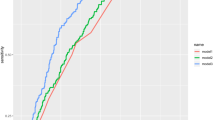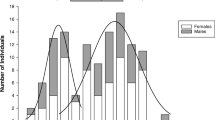Abstract
Falls are related to a complex interaction of risk factors. We examined if cardiac biomarkers for hemodynamic stress (N-terminal pro Brain Natriuretic Peptide—NT-proBNP), and for necrosis [high sensitive (hs) cardiac troponins T (cTnT) and I (cTnI)] are associated with falls in older people. Biomarkers were measured at baseline in a cohort of 1506 community-dwelling adults ≥65 years. Falls were assessed prospectively in a falls calendar (median 370 days). Cox-proportional hazards models evaluated the association of each biomarker with the incidence of the first fall accounting for established confounders. We observed 430 incident falls among 1327 participants and an effect modification by sex for all biomarkers. In multivariable analyses among men a one unit increment of log-transformed hs-cTnI was associated with a hazard ratio (HR) of 1.26 (95 % CI 1.04, 1.53). Men with hs-cTnT ≥ 14 ng/L had a HR of 1.74 (95 % CI 1.15, 2.61) compared to those with undetectable hs-cTnT levels. In women cTn were not associated with falls. We did not detect an association between NT-proBNP and the risk of fall. Our results suggest that cardiac troponins may not only identify subjects at risk for cardiovascular diseases, but also help to understand the underlying complex pathophysiology of falls.

Similar content being viewed by others
References
Tromp AM, et al. Fall-risk screening test: a prospective study on predictors for falls in community-dwelling elderly. J Clin Epidemiol. 2001;54(8):837–44.
Dionyssiotis Y. Analyzing the problem of falls among older people. Int J Gen Med. 2012;5:805–13.
Bell AJ, Talbot-Stern JK, Hennessy A. Characteristics and outcomes of older patients presenting to the emergency department after a fall: a retrospective analysis. Med J Aust. 2000;173(4):179–82.
Vellas BJ, et al. Fear of falling and restriction of mobility in elderly fallers. Age Ageing. 1997;26(3):189–93.
Clerico A, et al. The search for a pathophysiological link between gender, cardiac endocrine function, body mass regulation and cardiac mortality: proposal for a working hypothesis. Clin Chim Acta. 2009;405(1–2):1–7.
van Diepen S, et al. Heart failure is a risk factor for orthopedic fracture: a population-based analysis of 16,294 patients. Circulation. 2008;118(19):1946–52.
Stenhagen M, et al. Falls in the general elderly population: a 3- and 6- year prospective study of risk factors using data from the longitudinal population study ‘Good ageing in Skane’. BMC Geriatr. 2013;13:81.
Braunwald E. Biomarkers in heart failure. N Engl J Med. 2008;358(20):2148–59.
Thygesen K, et al. Recommendations for the use of natriuretic peptides in acute cardiac care: a position statement from the Study Group on Biomarkers in Cardiology of the ESC Working Group on Acute Cardiac Care. Eur Heart J. 2012;33(16):2001–6.
Morrow DA, et al. National Academy of Clinical Biochemistry Laboratory Medicine Practice Guidelines: clinical characteristics and utilization of biochemical markers in acute coronary syndromes. Clin Chem. 2007;53(4):552–74.
de Lemos JA, et al. Association of troponin T detected with a highly sensitive assay and cardiac structure and mortality risk in the general population. JAMA. 2010;304(22):2503–12.
deFilippi CR, et al. Association of serial measures of cardiac troponin T using a sensitive assay with incident heart failure and cardiovascular mortality in older adults. JAMA. 2010;304(22):2494–502.
Wallace TW, et al. Prevalence and determinants of troponin T elevation in the general population. Circulation. 2006;113(16):1958–65.
Agewall S, et al. Troponin elevation in coronary vs. non-coronary disease. Eur Heart J. 2011;32(4):404–11.
Denkinger MD, et al. Accelerometer-based physical activity in a large observational cohort-study protocol and design of the activity and function of the elderly in Ulm (ActiFE Ulm) study. BMC Geriatr. 2010;10:50.
Dallmeier D, et al. Sex-specific associations of established and emerging cardiac biomarkers with all-cause mortality in older adults: the ActiFE study. Clin Chem. 2015;61(2):389–99.
Lamb SE, et al. Development of a common outcome data set for fall injury prevention trials: the Prevention of Falls Network Europe consensus. J Am Geriatr Soc. 2005;53(9):1618–22.
World Health Organization. Falls Fact Sheet. 2012.
Wilson PW, et al. Prediction of coronary heart disease using risk factor categories. Circulation. 1998;97(18):1837–47.
Di Angelantonio E, et al. B-type natriuretic peptides and cardiovascular risk: systematic review and meta-analysis of 40 prospective studies. Circulation. 2009;120(22):2177–87.
Folstein MF, Folstein SE, McHugh PR. “Mini-mental state”. A practical method for grading the cognitive state of patients for the clinician. J Psychiatr Res. 1975;12(3):189–98.
D’Angelo G, Weissfeld L. An index approach for the Cox model with left censored covariates. Stat Med. 2008;27(22):4502–14.
Deandrea S, et al. Risk factors for falls in community-dwelling older people: a systematic review and meta-analysis. Epidemiology. 21(5): 658–68.
Carey BJ, Potter JF. Cardiovascular causes of falls. Age Ageing. 2001;30(Suppl 4):19–24.
Panel on Prevention of Falls in Older Persons, American Geriatrics Society and British Geriatrics Society. Summary of the Updated American Geriatrics Society/British Geriatrics Society clinical practice guideline for prevention of falls in older persons. J Am Geriatr Soc. 2011;59(1):148–57.
Rothenbacher D, et al. Prospective evaluation of renal function, serum vitamin D level, and risk of fall and fracture in community-dwelling elderly subjects. Osteoporos Int. 2014;25(3):923–32.
Majumdar SR, et al. Heart failure is a clinically and densitometrically independent risk factor for osteoporotic fractures: population-based cohort study of 45,509 subjects. J Clin Endocrinol Metab. 2012;97(4):1179–86.
Chung M, et al. Vitamin D with or without calcium supplementation for prevention of cancer and fractures: an updated meta-analysis for the U.S. Preventive Services Task Force. Ann Intern Med. 2011;155(12):827–38.
Saunders JT, et al. Cardiac troponin T measured by a highly sensitive assay predicts coronary heart disease, heart failure, and mortality in the Atherosclerosis Risk in Communities Study. Circulation. 2011;123(13):1367–76.
Omland T, et al. Prognostic value of cardiac troponin I measured with a highly sensitive assay in patients with stable coronary artery disease. J Am Coll Cardiol. 2013;61(12):1240-9.
Everett BM, et al. Sensitive cardiac troponin T assay and the risk of incident cardiovascular disease in women with and without diabetes mellitus: the Women’s Health Study. Circulation. 2011;123(24):2811–8.
Sabatine MS, et al. Detection of acute changes in circulating troponin in the setting of transient stress test-induced myocardial ischaemia using an ultrasensitive assay: results from TIMI 35. Eur Heart J. 2009;30(2):162–9.
Scharhag J, et al. Independent elevations of N-terminal pro-brain natriuretic peptide and cardiac troponins in endurance athletes after prolonged strenuous exercise. Am Heart J. 2005;150(6):1128–34.
Shave R, et al. Cardiac troponin I is released following high-intensity short-duration exercise in healthy humans. Int J Cardiol. 2010;145(2):337–9.
Horwich TB, et al. Cardiac troponin I is associated with impaired hemodynamics, progressive left ventricular dysfunction, and increased mortality rates in advanced heart failure. Circulation. 2003;108(7):833–8.
Baker JO, et al. Troponins: redefining their limits. Heart. 2011;97(6):447–52.
Jeremias A, Gibson CM. Narrative review: alternative causes for elevated cardiac troponin levels when acute coronary syndromes are excluded. Ann Intern Med. 2005;142(9):786–91.
Motiwala SR, et al. Biomarkers in ACS and heart failure: should men and women be interpreted differently? Clin Chem. 2014;60(1):35–43.
Omland T, et al. Impact of sex on the prognostic value of high-sensitivity cardiac troponin I in the general population: the HUNT study. Clin Chem. 2015;61(4):646–56.
Bodor GS, et al. Cardiac troponin T composition in normal and regenerating human skeletal muscle. Clin Chem. 1997;43(3):476–84.
Ricchiuti V, Apple FS. RNA expression of cardiac troponin T isoforms in diseased human skeletal muscle. Clin Chem. 1999;45(12):2129–35.
Aggarwal R, et al. Serum cardiac troponin T, but not troponin I, is elevated in idiopathic inflammatory myopathies. J Rheumatol. 2009;36(12):2711–4.
Cox FM, et al. The heart in sporadic inclusion body myositis: a study in 51 patients. J Neurol. 2010;257(3):447–51.
Rittoo D. American College of Cardiology Foundation recommendations assume incorrectly that cardiac troponins T and I are equally cardiac specific. J Am Coll Cardiol. 2013;61(13):1466–7.
Acknowledgments
The authors would like to thank Mrs. Gerlinde Trischler for expert technical assistance. The study was supported by grants from the Ministry of Science, Research and Arts, state of Baden-Wuerttemberg, Germany, as part of the Geriatric Competence Center, Ulm University, and the Hertha-Nathorff-Program for the professional development of female academic physicians to Dr D. Dallmeier, and by additional funds from the Department of Internal Medicine II-Cardiology, Ulm University.
Conflict of interest
The ARCHITECT STAT hs-cTnI assay was provided for free by Abbott. No funding organization had any role in the study design, data collection and analysis, decision to publish, or preparation of the manuscript.
Author information
Authors and Affiliations
Corresponding author
Additional information
The ActiFE study group consists further of: K. Scharffetter-Kochanek, Department of Dermatology and Allergology; H. Geiger, Institute Molecular Medicine and Stem Cell Research; A. Lukas, Agaplesion Bethesda Clinic, M. Riepe, Division of Gerontopsychiatry, Department of Psychiatry and Psychotherapy II; J.M. Steinacker, Department of Sports- and Rehabilitation Medicine; A. Ludolph, C. von Arnim, Department of Neurology; G. Nagel, G. Weinmayr, Institute of Epidemiology and Medical Biometry. All Institutes are located at Ulm University.
Electronic supplementary material
Below is the link to the electronic supplementary material.
Rights and permissions
About this article
Cite this article
Dallmeier, D., Klenk, J., Peter, R.S. et al. A prospective assessment of cardiac biomarkers for hemodynamic stress and necrosis and the risk of falls among older people: the ActiFE study. Eur J Epidemiol 31, 427–435 (2016). https://doi.org/10.1007/s10654-015-0059-9
Received:
Accepted:
Published:
Issue Date:
DOI: https://doi.org/10.1007/s10654-015-0059-9




